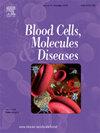Thalidomide confers therapeutic benefit in beta thalassemia patients by enhancing hemoglobin and hematopoietic gene expression: A non-randomized clinical trial
IF 1.7
4区 医学
Q3 HEMATOLOGY
引用次数: 0
Abstract
Bacground
Transfusion-dependent β-thalassemia (TDT) requires regular transfusions, often causing iron overload and organ damage. Thalidomide, a fetal hemoglobin (HbF) inducer, may reduce transfusion needs, but scientific data are limited.
Methods
This two-arm, non-randomized clinical trial followed a total of 164 TDT patients over 30 months: 72 received thalidomide and 92 underwent standard transfusions. Complete blood count was assessed at baseline and 6, 12, 18, 24, and 30 months. SNP genotyping and β-globin mutation analysis were performed using sanger sequencing. GATA-1 and KLF gene expression were assessed at baseline and after 30 months via qRT-PCR
Results
Hemoglobin level in the thalidomide group significantly increased from 6.12 ± 0.65 g/dL to 8.36 ± 2.04 g/dL (p < 0.001). Among thalidomide-treated patients, 34.7 % were excellent responders (ER), 25 % good responders (GR), 13.9 % partial responders (PR), and 26.4 % non-responders (NR). ERs showed the highest GATA-1 [3.09 (IQR 2.0–3.38)] and KLF [3.24 (IQR 3.01–5.42)] expression levels (p < 0.001). Better response was observed in patients with AFT >12 months and those carrying the minor allele C at HBS1L-MYB rs9399137 (p < 0.05)
Conclusion
Thalidomide effectively increases hemoglobin levels and reduces transfusion needs in TDT patients, particularly through upregulation of GATA-1 and KLF. AFT and SNP genotype at HBS1L-MYB rs9399137 may help predict response
Trial registration
ClinicalTrials.gov ID: NCT06146478
沙利度胺通过提高血红蛋白和造血基因表达,为地中海贫血患者提供治疗益处:一项非随机临床试验
输血依赖性β-地中海贫血(TDT)需要定期输血,经常导致铁超载和器官损伤。沙利度胺是一种胎儿血红蛋白(HbF)诱导剂,可能会减少输血需求,但科学数据有限。方法这项双组非随机临床试验共随访164例TDT患者30个月,其中72例接受沙利度胺治疗,92例接受标准输血。在基线和6、12、18、24和30个月时评估全血细胞计数。采用sanger测序进行SNP基因分型和β-珠蛋白突变分析。在基线和30个月后通过qrt - pcr评估GATA-1和KLF基因表达结果:沙利度胺组血红蛋白水平从6.12±0.65 g/dL显著升高至8.36±2.04 g/dL (p <;0.001)。在沙利度胺治疗的患者中,34.7%为优秀反应者(ER), 25%为良好反应者(GR), 13.9%为部分反应者(PR), 26.4%为无反应者(NR)。er组GATA-1 [3.09 (IQR 2.0-3.38)]和KLF [3.24 (IQR 3.01-5.42)]表达水平最高(p <;0.001)。aft12个月患者和携带HBS1L-MYB rs93999137等位基因C的患者疗效更好(p <;0.05)结论沙利度胺可有效提高TDT患者血红蛋白水平,减少输血需求,特别是通过上调GATA-1和KLF。HBS1L-MYB rs93999137的AFT和SNP基因型可能有助于预测反应
本文章由计算机程序翻译,如有差异,请以英文原文为准。
求助全文
约1分钟内获得全文
求助全文
来源期刊
CiteScore
4.90
自引率
0.00%
发文量
42
审稿时长
14 days
期刊介绍:
Blood Cells, Molecules & Diseases emphasizes not only blood cells, but also covers the molecular basis of hematologic disease and studies of the diseases themselves. This is an invaluable resource to all those interested in the study of hematology, cell biology, immunology, and human genetics.

 求助内容:
求助内容: 应助结果提醒方式:
应助结果提醒方式:


